Related Research Articles
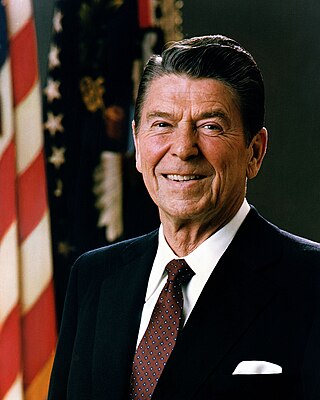
Ronald Wilson Reagan was an American politician and actor who served as the 40th president of the United States from 1981 to 1989. A member of the Republican Party, his presidency constituted the Reagan era, and he is considered one of the most prominent American conservative figures.

The Reagan Doctrine was a United States strategy implemented by the Reagan Administration to overwhelm the global influence of the Soviet Union in the late Cold War. As stated by US President Ronald Reagan in his State of the Union address on February 6, 1985: "We must not break faith with those who are risking their lives—on every continent from Afghanistan to Nicaragua—to defy Soviet-supported aggression and secure rights which have been ours from birth." The doctrine was a centerpiece of United States foreign policy from the early 1980s until the end of the Cold War in 1991.

The history of the United States from 1980 until 1991 includes the last year of the Jimmy Carter presidency, eight years of the Ronald Reagan administration, and the first three years of the George H. W. Bush presidency, up to the collapse of the Soviet Union. Plagued by the Iran hostage crisis, runaway inflation, and mounting domestic opposition, Carter lost the 1980 United States presidential election to Republican Reagan.
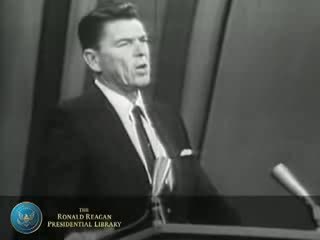
"A Time for Choosing", also known as "The Speech", was a speech presented during the 1964 U.S. presidential election campaign by future president Ronald Reagan on behalf of Republican candidate Barry Goldwater. "A Time for Choosing" launched Reagan into national prominence in politics.

Ronald Reagan's tenure as the 40th president of the United States began with his first inauguration on January 20, 1981, and ended on January 20, 1989. Reagan, a Republican from California, took office following his landslide victory over Democrat incumbent president Jimmy Carter and independent congressman John B. Anderson in the 1980 presidential election. Four years later, in the 1984 presidential election, he defeated former Democratic vice president Walter Mondale, to win re-election in a larger landslide. Reagan was succeeded by his vice president, George H. W. Bush, who won the 1988 presidential election. Reagan's 1980 landslide election resulted from a dramatic conservative shift to the right in American politics, including a loss of confidence in liberal, New Deal, and Great Society programs and priorities that had dominated the national agenda since the 1930s.
These are the references for further information regarding the history of the Republican Party in the U.S. since 1854.

Paul G. Kengor is an author and professor of political science at Grove City College and the senior director of the Institute for Faith and Freedom, a Grove City College think tank. He is a visiting fellow at Stanford University's Hoover Institution on War, Revolution, and Peace. Kengor has focused much of his work on Ronald Reagan, faith and the presidency, conservative politics, the Cold War, Communism, and Catholicism.
American foreign policy during the presidency of Ronald Reagan (1981–1989) focused heavily on the Cold War which shifted from détente to confrontation. The Reagan Administration pursued a policy of containment and rollback with regards to communist regimes. The Reagan Doctrine operationalized these goals as the United States offered financial, logistical, training, and military equipment to anti-communist opposition in Afghanistan, Angola, and Nicaragua. He expanded support to anti-communist movements in Central and Eastern Europe.
This bibliography of Richard Nixon includes publications by Richard Nixon, the 37th president of the United States, and books and scholarly articles about him and his policies.
Books about and authored by Jimmy Carter, the 39th president of the United States (1977–1981).

Jimmy Carter's tenure as the 39th president of the United States began with his inauguration on January 20, 1977, and ended on January 20, 1981. Carter, a Democrat from Georgia, took office following his narrow victory over Republican incumbent president Gerald Ford in the 1976 presidential election. His presidency ended following his landslide defeat in the 1980 presidential election to Republican Ronald Reagan, after one term in office. Aged 99, he is the oldest living, longest-lived and longest-married president, and has the longest post-presidency. He is also the fourth-oldest living former state leader.

This article discusses the domestic policy of the Ronald Reagan administration from 1981 to 1989. Reagan's policies stressed conservative economic values, starting with his implementation of supply-side economic policies, dubbed as "Reaganomics" by both supporters and detracters. His policies also included the largest tax cut in American history as well as increased defense spending as part of his Soviet strategy. However, he significantly raised (non-income) taxes four times due to economic conditions and reforms, but the tax reforms instituted during presidency brought top marginal rates to their lowest levels since 1931, such that by 1988, the top US marginal tax rate was 28%.
Ronald Reagan was the 40th president of the United States from 1981 to 1989. Previously, he was the 33rd governor of California from 1967 to 1975 and acted in Hollywood films from 1937 to 1964, the same year he energized the American conservative movement. Reagan's basic foreign policy was to equal and surpass the Soviet Union in military strength, and put it on the road to what he called "the ash heap of history". By 1985, he began to cooperate closely with Soviet leader Mikhail Gorbachev, with whom he became friends and negotiated large-scale disarmament projects. The Cold War was fading away and suddenly ended as the Soviets lost control of Eastern Europe almost overnight in October 1989, nine months after Reagan was replaced in the White House by his vice president, George H. W. Bush, who was following Reagan's policies. The dissolution of the Soviet Union took place in December 1991. In terms of the Reagan Doctrine, he promoted military, financial, and diplomatic support for anti-communist insurgencies in Afghanistan, Nicaragua, and numerous other countries. For the most part, local communist power collapsed when the Soviet Union collapsed.

The Reagan era or the Age of Reagan is a periodization of recent American history used by historians and political observers to emphasize that the conservative "Reagan Revolution" led by President Ronald Reagan in domestic and foreign policy had a lasting impact. It overlaps with what political scientists call the Sixth Party System. Definitions of the Reagan era universally include the 1980s, while more extensive definitions may also include the late 1970s, the 1990s, and even the 2000s. In his 2008 book, The Age of Reagan: A History, 1974–2008, historian and journalist Sean Wilentz argues that Reagan dominated this stretch of American history in the same way that Franklin D. Roosevelt and his New Deal legacy dominated the four decades that preceded it.
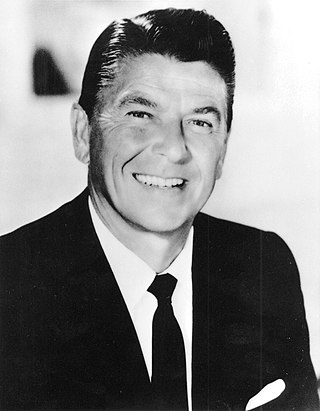
Ronald Reagan was the 33rd governor of California for two terms, the first beginning in 1967 and the second in 1971. He left office in 1975, declining to run for a third term. Robert Finch, Edwin Reinecke and John L. Harmer served as lieutenant governors over the course of his governorship.

This timeline of modern American conservatism lists important events, developments and occurrences that have affected conservatism in the United States. With the decline of the conservative wing of the Democratic Party after 1960, the movement is most closely associated with the Republican Party (GOP). Economic conservatives favor less government regulation, lower taxes and weaker labor unions while social conservatives focus on moral issues and neoconservatives focus on democracy worldwide. Conservatives generally distrust the United Nations and Europe and apart from the libertarian wing favor a strong military and give enthusiastic support to Israel.
This is a selective bibliography of conservatism in the United States covering the key political, intellectual and organizational themes that are dealt with in Conservatism in the United States. Google Scholar produces a listing of 93,000 scholarly books and articles on "American Conservatism" published since 2000. The titles below are found in the recommended further reading sections of the books and articles cited under "Surveys" and "Historiography." The "Historiography" and "Critical views" section mostly comprise items critical or hostile of American conservatism.

The speeches and debates of Ronald Reagan comprise the seminal oratory of the 40th President of the United States. Reagan began his career in Iowa as a radio broadcaster. In 1937, he moved to Los Angeles where he started acting, first in films and later television. After delivering a stirring speech in support of Barry Goldwater's presidential candidacy in 1964, he was persuaded to seek the California governorship, winning two years later and again in 1970. In 1980, as the Republican nominee for president of the United States, he defeated incumbent Jimmy Carter. He was reelected in a landslide in 1984, proclaiming that it was "Morning in America". Reagan left office in 1989.
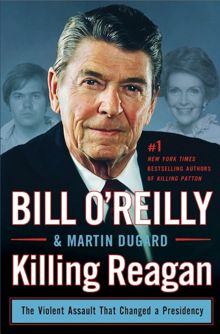
Killing Reagan: The Violent Assault That Changed a Presidency is a book written by Bill O'Reilly and Martin Dugard about the attempted assassination of U.S. President Ronald Reagan in 1981. It is the fifth in the Killing series, following Killing Lincoln, Killing Kennedy, Killing Jesus, and Killing Patton. The book was released on September 22, 2015, and topped The New York Times Best Sellers List.
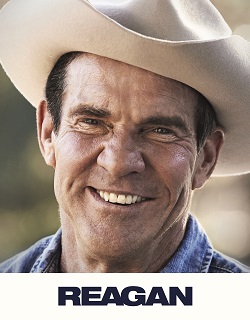
Reagan is a 2024 American biographical drama film directed by Sean McNamara and written by Howard Klausner, based on Paul Kengor's 2006 book The Crusader: Ronald Reagan and the Fall of Communism. The film stars Dennis Quaid as President Ronald Reagan alongside Penelope Ann Miller and Jon Voight, with Robert Davi and Lesley-Anne Down in supporting roles.
References
- ↑ Woodard 2012, p. 191.